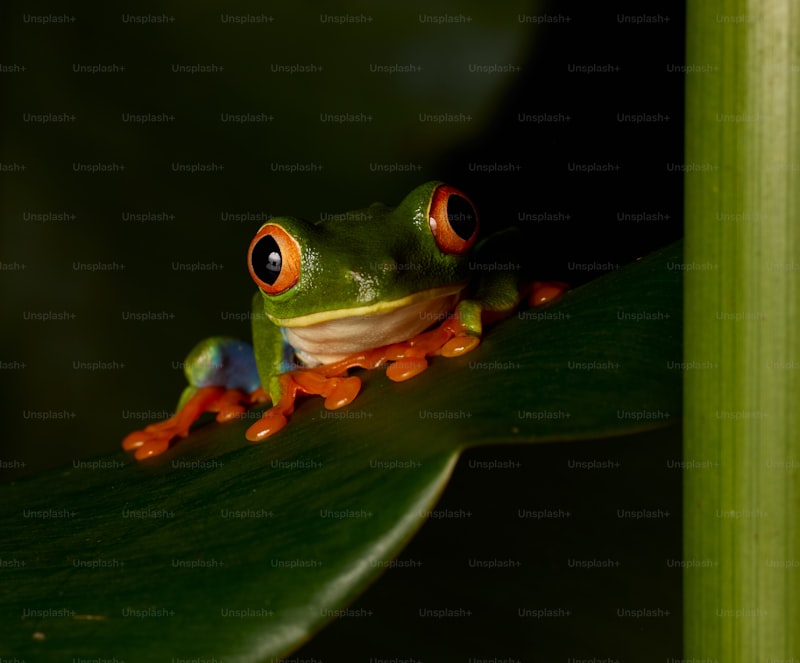Have you ever wondered how amphibians like frogs and salamanders develop from tiny eggs into complex creatures? The developmental biology of amphibians offers a fascinating glimpse into this transformative process. Unlike mammals, which develop internally, amphibians undergo external development starting from the moment their eggs are laid in water or moist environments.
Amphibian development begins with fertilization, where sperm meets egg, triggering a cascade of events. The fertilized egg, or zygote, undergoes rapid cell divisions, forming a hollow ball of cells known as a blastula. This early stage sets the foundation for subsequent development.
As development progresses, the blastula undergoes a process called gastrulation, where it transforms into a gastrula with three distinct layers: ectoderm, mesoderm, and endoderm. These layers give rise to different tissues and organs as the embryo continues to grow.
One of the most remarkable features of amphibian development is metamorphosis. Many amphibians, like frogs, undergo metamorphosis from aquatic larvae (tadpoles) to terrestrial adults. This transformation involves dramatic changes in morphology, physiology, and behavior, facilitated by hormonal signals triggered by environmental cues like water quality and temperature.
During metamorphosis, tadpoles develop limbs, lose their tails, and transition to a diet suited for their adult life on land. This process highlights the adaptive nature of amphibians and their ability to thrive in diverse environments.
Studying the developmental biology of amphibians provides insights into evolutionary processes and adaptations to terrestrial life. Researchers use amphibians as model organisms to understand fundamental biological principles that apply across species, including humans.
The developmental biology of amphibians offers a window into nature’s incredible capacity for transformation and adaptation. By unraveling the mechanisms behind amphibian development, scientists deepen our understanding of life’s diversity and the evolutionary forces shaping our natural world.
Unveiling Nature’s Architects: The Intricate Developmental Biology of Amphibians
Amphibians, those fascinating creatures that straddle the realms of land and water, are truly nature’s architects. From their humble beginnings as tiny embryos to their metamorphic transformations, the developmental biology of amphibians offers a glimpse into the wonders of evolutionary adaptation.
One of the most remarkable aspects of amphibian development is their dual life stages: aquatic larvae and terrestrial adults. This metamorphosis is orchestrated by a complex interplay of hormonal changes and genetic programs. As tadpoles, they navigate water with delicate gills and tails, gradually morphing into adults equipped with lungs and limbs for life on land.
Central to their development is the phenomenon of metamorphosis, a biological marvel where tissues and organs undergo profound restructuring. Limbs bud, tails regress, and lungs mature, all under precise genetic control. This process not only highlights the adaptability of amphibians but also underscores their crucial role in ecosystem dynamics.
Analogous to nature’s architects, amphibians sculpt their own destiny through adaptation. Their ability to thrive in diverse environments—from rainforests to deserts—showcases their resilience and evolutionary success. They are pioneers in ecological niches, bridging aquatic and terrestrial ecosystems and influencing their biodiversity.
Furthermore, amphibian developmental biology offers insights into broader scientific inquiries, such as regenerative medicine and evolutionary biology. Their unique ability to regenerate limbs and repair damaged tissues intrigues researchers worldwide, holding promise for future medical treatments.
In essence, the study of amphibian developmental biology unveils a narrative of resilience, adaptation, and scientific wonder. It invites us to marvel at the intricate mechanisms that shape these remarkable creatures and their profound impact on the natural world.
From Tadpole to Frog: Exploring the Evolutionary Wonders of Amphibian Development
Ever wondered how a tiny tadpole transforms into a fully formed frog? The journey from aquatic larva to terrestrial adult is nothing short of miraculous, showcasing nature’s incredible adaptability and evolutionary prowess.

Amphibian development begins in water, where eggs hatch into tadpoles. These aquatic larvae possess gills for breathing underwater and a tail for swimming. As they grow, tadpoles undergo a series of metamorphic changes that prepare them for life on land. One of the most remarkable transformations occurs in their respiratory system: gills are replaced by lungs, enabling them to breathe air instead of relying on water alone.
During metamorphosis, limbs begin to develop, initially as tiny buds that gradually elongate and differentiate into legs. The tail, once essential for swimming, shrinks and is absorbed as energy for the growing froglet. This process is fueled by hormones like thyroxine, which orchestrate the timing and sequence of changes.
As the tadpole’s body shape shifts from streamlined to more frog-like, its diet also undergoes a significant shift. Initially herbivorous, tadpoles transition to carnivorous diets, preparing them for the predatory lifestyle of adult frogs. This dietary change is crucial for their development and growth into mature amphibians.
Amphibians play a vital ecological role, serving as indicators of environmental health due to their sensitivity to pollution and habitat changes. Understanding their development from tadpole to frog provides insights into broader ecological processes and conservation efforts.
Next time you spot a frog in a pond or hopping along a forest floor, marvel at its journey from tadpole obscurity to charismatic adulthood. Their transformation encapsulates the wonder of nature’s evolutionary mechanisms, adapting and thriving in diverse environments worldwide.
Metamorphosis Unraveled: How Amphibians Transform During Development
Picture the tadpole’s early days, its sleek body designed for swift movement underwater, a testament to life in ponds and streams. Yet, as time advances, so does its form: forelimbs appear, mirroring the journey towards land. Remarkably, its dietary needs alter—shifting from plant-based to carnivorous—as it prepares for its new terrestrial lifestyle. Such adaptations aren’t merely biological necessities but strategic choices, honed over millennia to ensure survival.
The frog’s transformation isn’t just about physical change; it’s a narrative of adaptation and survival. Imagine the tadpole’s world shrinking as legs replace its fin-like tail, a metamorphosis akin to shedding an old life for a new one. Each stage, from aquatic to terrestrial, embodies nature’s resilience and the ability to thrive in diverse habitats.
Metamorphosis isn’t confined to frogs alone; it’s a universal symbol of growth and transformation. Consider the toad, undergoing similar changes with its own unique twist. From tadpole to terrestrial, each species embraces metamorphosis in its distinct way, showcasing nature’s creative prowess.
Metamorphosis isn’t just a biological process—it’s a saga of adaptation and evolution. It underscores nature’s capacity for transformation, painting a picture of resilience and ingenuity. Witnessing amphibians metamorphose is akin to glimpsing nature’s magic, where change isn’t merely inevitable but a celebration of life’s enduring spirit.
Environmental Signals and Genetic Prowess: Key Drivers in Amphibian Development
Amphibians, those fascinating creatures that straddle the line between aquatic and terrestrial life, owe much of their developmental marvels to a delicate interplay of environmental cues and genetic predispositions. Unlike many other organisms, amphibians undergo a remarkable transformation from aquatic larvae to terrestrial adults, guided intricately by both external signals and internal genetic programs.
One of the pivotal environmental factors influencing amphibian development is temperature. From the moment their eggs are laid in water, amphibian embryos are highly sensitive to temperature fluctuations. Warmer temperatures can accelerate development, leading to faster hatching and growth rates, while colder temperatures may slow down these processes. This sensitivity underscores their adaptability to varying climates and habitats, a testament to their evolutionary resilience.
Furthermore, water quality plays a crucial role in amphibian development. Pollution and contaminants in aquatic environments can disrupt normal growth patterns, affecting everything from larval development to immune system function. Amphibians, with their permeable skin, absorb substances directly from the water, making them highly susceptible to environmental changes and pollutants. This sensitivity makes them vital indicators of ecosystem health and biodiversity.
Genetically, amphibians exhibit a diverse array of adaptations that facilitate their unique life cycles. Evolution has equipped them with genetic predispositions for metamorphosis, enabling them to undergo radical physiological changes as they transition from water-breathing larvae to air-breathing adults. These genetic programs are finely tuned over millions of years, reflecting the intricate balance between adaptation and survival in diverse ecological niches.
Regeneration Marvels: Amphibian Limbs and Tissue Development Explored
Amphibians like salamanders and newts have a remarkable ability to regenerate lost limbs. Imagine if humans could do the same—breaking an arm wouldn’t be such a big deal anymore! This ability has intrigued scientists for decades, leading to groundbreaking discoveries in biology and medicine.
When an amphibian loses a limb, something magical happens at the cellular level. Specialized cells, called progenitor cells, swing into action. These cells are like the superheroes of regeneration—they divide rapidly and migrate to the site of injury. It’s as if they have a built-in GPS to navigate precisely where they’re needed most.
Once at the injury site, these progenitor cells get to work. They differentiate into various cell types—muscle cells, bone cells, nerve cells, you name it—and start rebuilding the lost limb. It’s like a construction crew following a blueprint to erect a new building, except this “building” is a perfectly formed limb.
What’s even more mind-blowing is the speed at which this regeneration occurs. While it may take weeks or even months for a human to recover from a serious injury, amphibians can regenerate entire limbs within weeks. It’s nature’s own fast-track healing process.
Scientists have been studying these processes intensely, hoping to unlock the secrets of regeneration for potential applications in human medicine. Imagine a future where we can regenerate damaged organs or tissues—amphibians might hold the key to making this a reality.
Evolutionary Echoes: Comparing Amphibian Development to Mammals and Reptiles

Have you ever wondered how different animals develop before they’re born? It’s fascinating to compare how amphibians, mammals, and reptiles go through their early stages of life. Each group has its own unique journey from embryo to fully-formed creature, showing us the incredible diversity of evolution’s paths.
Amphibians, like frogs and salamanders, start their lives in water. Their eggs lack a protective shell, so they must remain moist to survive. After hatching, they go through a larval stage where they have gills and tails, resembling small fish. As they mature, they undergo metamorphosis, developing lungs and legs to adapt to life on land. This transition from water to land is a remarkable evolutionary adaptation that sets amphibians apart.
Mammals, on the other hand, have a different approach. They develop inside their mothers’ bodies, protected and nourished by the placenta. This internal development allows mammals to grow and mature in a stable environment, where they receive all their nutrients through the umbilical cord. After birth, mammals continue to develop rapidly, often relying on milk for nourishment until they can hunt or forage on their own.
Reptiles, like turtles and snakes, lay eggs with tough, leathery shells that provide protection from the environment. These eggs are typically buried in warm sand or soil, where they incubate until they’re ready to hatch. Once hatched, young reptiles are independent and must fend for themselves from the start. They often resemble miniature versions of their parents, equipped with scales or shells for protection against predators.
Comparing these developmental pathways highlights the incredible adaptability of vertebrate animals. From amphibians’ aquatic beginnings to mammals’ internal nurturing and reptiles’ self-sufficiency from birth, each group has evolved unique strategies to ensure survival in diverse habitats. Understanding these evolutionary echoes not only enriches our knowledge of biology but also deepens our appreciation for the natural world’s complexity and beauty.
Frequently Asked Questions
What are the key factors influencing amphibian embryogenesis?
Key factors influencing amphibian embryogenesis include environmental conditions (such as temperature and humidity), genetic factors, and developmental timing cues. These elements collectively impact the growth and differentiation of embryos during their early stages of development.
How do amphibians undergo metamorphosis?
Discover how amphibians transform through metamorphosis, a natural process where they undergo significant physical changes from larval to adult stages. Explore the stages and biological mechanisms involved in this fascinating life cycle adaptation.
What are the stages of embryonic development in amphibians?
Learn about the stages of embryonic development in amphibians, from fertilization to hatching. Understand how these stages contribute to the formation of vital organs and structures in amphibian embryos.
How do environmental factors impact amphibian development?
Learn about how environmental factors influence the development of amphibians, including temperature, humidity, water quality, and habitat type. Understand their critical role in shaping growth, metamorphosis, and overall survival of amphibian species.
What are the similarities and differences between amphibian and human embryonic development?
Learn about the similarities and differences between amphibian and human embryonic development in this concise FAQ. Explore how both processes begin with fertilization but diverge in terms of early development stages and final outcomes. Understand the key milestones such as gastrulation and organogenesis, highlighting evolutionary adaptations and biological distinctions between these two developmental pathways.



[…] Developmental Biology of Amphibians […]